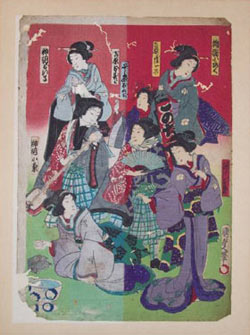sun fading of art works

Most people are probably aware of the power of sunlight in fading the colours of carpets, upholstery and drapes. I wonder how many realize the sun’s effect on the art work on the walls. Now we can see for ourselves in this very revealing article by Thomas Crossland: Sun-Fading and UV-Glass Experiment.
Thanks to Julio at BarenForum, a woodblock printmakers’ group blog, for pointing out this link.
I have been told that plexiglass offers some protection. I have a print of my own framed with plexiglass on a wall that does get some sun on it in the late afternoon some times of the year, and it has faded in the decade it’s been there. I think now there is a better grade plexiglass available, which may be more protective. It would be very interesting to see this kind of test to prove out the claim. Have you noticed how many museums display very old works under very dim lighting?
If you want to know more about caring for the art on your walls, including photographs, check out my earlier piece as well as the excellent Wilhelm Imaging Research.
April 7, 2006 in Care of Art Works by Marja-Leena
Worrying things here, even for amateur digital photographers. It must be critical for you.(We have been copying old photos to disk in a quest for permanence, but I bet the technology will change again.) When I have time, I want to read that Bill Gates article at Wilhelm.
This whole business of fugitive colours is fascinating. I have been worried about what would happen to my work, but thank goodness so far there has been no fading – although I definitely keep everything out of direct sunlight. My worst nightmare with fugitive inks used to be when I was publishing: some artists liked the luminous colours of some inks, and I did have one picturebook’s illustrations virtually fade under my very eyes!
Anna, we have plans to do the same with old family photos in our retirement. Even our wedding photos have changed colour in a non-acid-free photo album! And ever changing digital storage media is a real headache isn’t it? I still have files on Zip disks to transfer before we give away our old Mac.
Omega – Dye based colours seem to fade faster (I think) than pigment based. I used to batik years ago with Procion dyes which did fade. How do you find the dyes you use in your art practice today?
That book – was the paper acid-free? If not, colours will fade for that reason as well. But you probably know that already.
The inks/dyes in my own work are the printer’s inks plus the chemicals used on the transfer paper. As far as the commercially dyed larger printing is concerned, the printer’s work is mostly for fashion designers, and so their inks are fully non-fugitive – and I have not had long enough experience of their work to see whether it does fade.
There is such a thing as UV glass and UV plexi glass that dramatically reduces the effects of the sun on art works. They are more expensive, but any frame shop should carry them. Museums also use a special glass which is extremely expensive, but it is definitley worth the price in the long run. Also it is important to frame your art using museum rag acid free matt board and foam core backing. A lot of people come in to our frameshop with “acid free” mattboard from the 1980’s and 70’s, but it is already yellow, and the artwork has an ugly yellow outine on it.
Hope this helps.
Mandy, thanks for the input! I do know about what you say here. This article however questions the claims of the UV glass. Maybe there are differences in the manufacturers’ products?